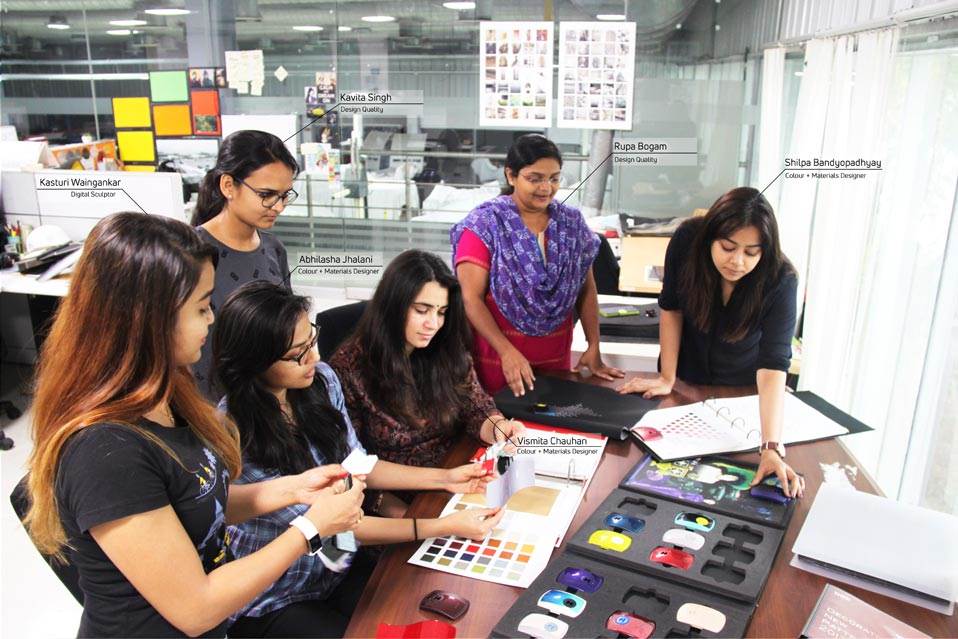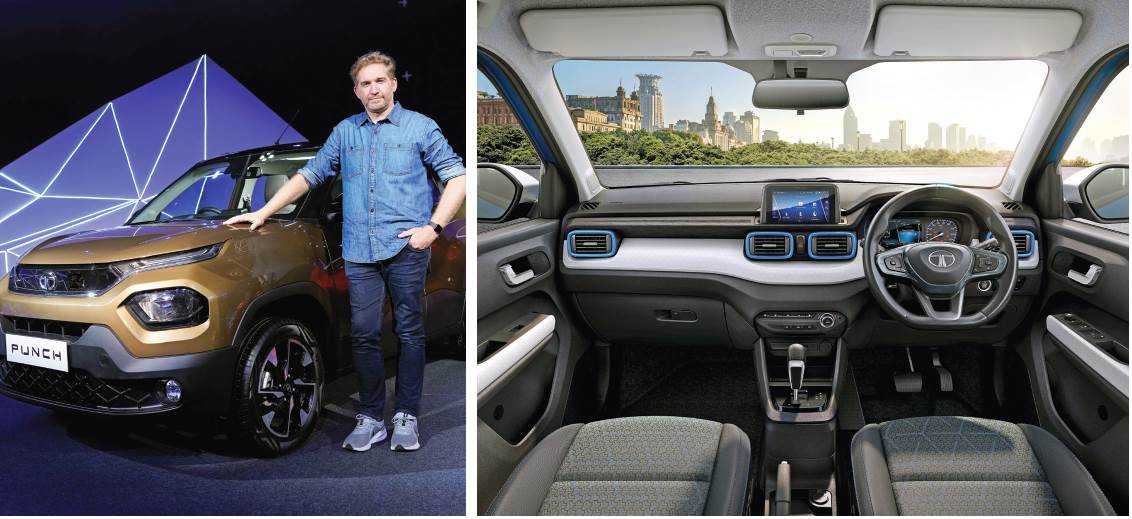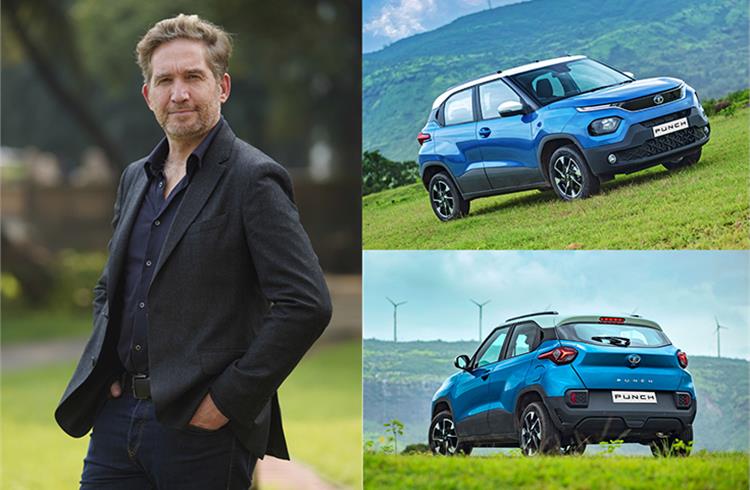Tata Motors’ Martin Uhlarik: ‘From designing the product, we are now designing the experience.’
Martin Uhlarik, Head of Global Design at Tata Motors, discusses changing trends in design which also came in handy for the Tata Punch.
Martin Uhlarik, Head of Global Design at Tata Motors, discusses changing trends in design which also came in handy for the Punch. He talks to Murali Gopalan about expansions planned across the three design studios where new tech, competencies and women power will play a bigger role going forward.
Martin Uhlarik is clearly excited as we begin chatting over a video call between India and the UK. As Head of Global Design at Tata Motors, he has every reason to feel upbeat with the launch of the Punch micro-SUV where the creative teams across the studios in India, Italy and the UK went all out to work on the new offering.
“The Punch is important to me and kind of a first baby. I joined the company five years ago and one of the first programmes and projects that I got involved with was its development,” says Uhlarik who took charge as Design Head six months ago.
There is another reason for his upbeat mood and he explains why. ”We are actually right now in the process of quite a big expansion across our studios and have identified new areas which are not the sort of traditional design specialities,” says Uhlarik.
Consequently, personnel are being ramped up in these areas because “we know it is a strategic investment” going into the future. VR (virtual reality) is one tool to “help us implement our ideas” and a large investment is being made in HMI (human machine interface) design too.
Beyond this, the design team is also looking at understanding social trends in brands which is essentially about consumer psychology. This is not about having a traditional car designer but somebody who has a finger on the pulse in terms of what is happening out there. He/she can then bring some of that thinking into “our old school thinking” from a designer’s point of view and then say “maybe we should be looking at it”.
As Uhlarik reiterates, the benchmark for this initiative is just not automotive and the reference points could actually be in diverse industries like electronics or footwear. The idea is to carefully observe how these sectors are designing their products or engaging with customers.
“We are now looking to expand the design department to have people/specialists who can actually focus on this. Each studio needs to have a USP and different locations bring different perspectives . . . competition is good because it stimulates everyone to deliver the best results,” says the Tata Motors Design Head.
Engendering equality
The expansion across the design studios will also involve “doing quite a lot” in terms of hiring female designers. Traditionally, automotive design is a kind of a male-dominated industry…”it always has been”. Even when Uhlarik was in school, for every nine male students, there was just one female student and traditionally they would end up in colour materials departments.

Women in Tata Motors’ design team, who are engaged in interior and exterior design, design quality, design operations and planning and CAS modelling. (Image: Tata Motors.com)
“There was a kind of stereotype and now we are really broadening and actually encouraging that we have a much more cross-pollinated design team . . . in order to understand perspectives and customer wants/needs and so forth. It is very important to broaden our appeal,” says Uhlarik.
From his point of view, younger designers are bringing in a completely different mindset/approach and “they are the ones enlightening me”. Just prior to this interview, he had had a review and was “absolutely inspired” by some of the ideas put forward by the young designers. “And it is all being brought with optimism and enthusiasm…they are extremely positive,” he says.
This is particularly important when the auto industry is constantly being challenged simply because everything is getting a lot quicker. “It is extremely fast now and we need to adopt different methodologies,” says Uhlarik. For instance, the pandemic unlocked digital tools in the design process which really was a big help from the viewpoint of greater efficiency.
The topic then veers around to the mobility landscape and what this will mean for auto designers in terms of their creative juices. “It is important we understand how mobility will be defined in terms of ownership models and user interface,” he says.
Designing the product physically is one aspect of the design job in making it look attractive but design is also about solving problems and finding solutions. “And part of that is understanding social trends, value systems of our customers, where change is happening, how technology is going to influence mobility over the next decade and so on,” elaborates Uhlarik.
Essentially, it means the need to have a short-term solution but also to “know roughly where you are going to be in 10 years” and to maintain that from a company/brand point of view. “So customers are taken on that journey and we are all part of that together. There are no rapid turns of left and right or no sort of schizophrenia in terms of direction,” he says.
It is all part of curating and maintaining the brand messaging that everything is under control…”we know we have a lot of challenges ahead of us and yet we are part of the solution going forward”. People were also talking of shared economy being the future business model and the rise of Uber and Ola till the pandemic came along.
Today, the same users are hesitant and prefer to have personal mobility again from a safety/security point of view. All of this is constantly influencing the designer community too as “we ride out the challenges globally”. As Uhlarik adds, all of this influences design not only on how people interface with products and services but they are also influencing everything down to colour, subconscious aesthetics, interface and so forth.
A 24x7 job
“It is really fascinating and a designer’s job is 24x7 where you are constantly being influenced by everything around you and it is always feeding your output,” he says. This again puts in context the need for Tata Motors to have three global design studios. “We want to get inputs from people with global experience and also different perspectives on what are the trends emerging globally,” explains Uhlarik.
Obviously the top priority is India which has “specific peculiarities” focused on customer/geographical needs and so forth. The Indian market is the “next big frontier” for the automotive world — “if you look at the number of vehicles sold and when you look at the predictions in volumes and then you look at the demographics, India is a young country with half the population under 35”.
As Uhlarik says, understanding the value system of that slice of the population — “and I am not saying you are marginalising the other ones” — is critical. “If you capture their imagination and understand that demography you obviously have a sustainable business model in India,” he adds.
Today, almost all carmakers bring global products to this market and sometimes they resonate and sometimes they don't. It is Uhlarik’s conviction that one needs to understand the Indian consumer to unlock that specific DNA but at the same time “our products have to be globally competitive”.
As he puts it, “If you sell in India, you must have a globally competitive product because the consumer has those expectations already. It is an interesting combination of local but global and over the next 10 years this is going to be the real frontier in terms of competitiveness.”
For a designer, it is important to understand what is the purpose of the product/vehicle and what it is supposed to do. Essentially, it is meant to make consumers' lives easier and a designer has to “always look through that lens”. According to Uhlarik, designing an automotive product fundamentally is to have good proportions from an exterior point of view.
“It does not matter which market you are selling in and which category you are designing for. The car needs to have a good stance and even if a person is not design-literate, they will make a judgement within three to five seconds. They will look at a product and will subconsciously decide if they like it or not,” he says.

On the interior, this is a different discipline because there are a number of variables coming together like ergonomics, comfort, atmosphere and ambience whether one is the driver or passenger. “When I was studying design, we were taught you are designing the product but now we are designing the experience. You have to really think psychologically as a designer how all those things come together. It is really fascinating,” says Uhlarik.
Technology, likewise, is always an influencer on design as also social trends in terms of the psychology of buying. Online shopping is the big thing today for youngsters and the challenge for a company selling a product is to make it as engaging, compelling and give that confidence to the consumer. “Vehicles are more of a challenge because it is the second biggest thing after a home…it is not an impulsive buying decision,” he says.
Four disruptors of auto industry of the future
The four “massive disruptors” in the auto industry over the next decade are electrification, connectivity, autonomy and the ownership model (how will people buy a vehicle). As Uhlarik says, companies need to digest this reality and the investments involved.
“As a creative person, I find it quite exciting since I don't remember facing these sorts of challenges ever in my career. A designer’s job is to find solutions, make things simpler, just process those things and hopefully come up with a solution,” he adds.
He is also aware that vehicles of the future will need to go the extra mile in making their occupants as comfortable as possible. Given the rapid pace of urbanisation, experts say that a car will essentially need to be a home away from home especially when people are stuck in traffic forever.
“When you are spending time in a vehicle, should it be time wasted or used so that it does not disrupt your life? It should be a natural segue and when you commute for a long while, is it productive that contributes to better health or a negative experience? These are the things we need to consider as designers and my creative team is always being challenged,” says Uhlarik.
Number Punch-ing
The time has now come to talk about the Punch which Tata Motors is banking on to keep the momentum going in the numbers game. For the design team, the challenge lay in creating a competitive product in this product category. “That was something I was really excited about. This was truly a global project and programme. We had proposals for exterior and interior coming from the studios in Pune, Italy and the UK,” he recalls.
Oddly enough, the selection process “kind of picked bits” from every studio and then all three worked on preparing it for production. One could term this a sort of precycle in terms of feasibility, manufacturability and at the same time the challenge for design.
“It is one thing to have a vision of 'this is the product we would like to see'. Yet, it is another thing to actually implement that from a feasibility/quality point of view and also value point because it is a competitively priced product,” says Uhlarik.
Getting that perception of value as well as all of those features and elements into the price, both exterior and interior, and then all of it coming together in a complete package “was very satisfying”. As he explains, putting a car on the road is the real litmus test for a designer. “You can be very creative and come up with a great vision, concept or direction but actually getting there is the real test,” he says.
Today, the Punch is a reality and Uhlarik is justifiably “very proud” of the work everybody did — there was a lot of blood, sweat and tears behind the scenes but in the end it was “well worth it”. For a designer, it is also important to have a “certain viability” on the horizon.

H2X concept at the 2019 Geneva Motor Show previewed the Punch micro-SUV model which Tata Motors believes is the next big thing that will help expand its footprint in the ultra-competitive Indian PV market.
“Here we are in 2021 and we showed the H2X concept in Geneva back in 2019. That is when we said we are investigating going into this segment with this type of a product. So, it was a little bit of what a concept usually does . . . you are kind of just testing the waters,” he narrates.
In a nutshell, this meant that the designers at that time in 2019 were already focused on delivering the vehicle for 2021. A car has a life cycle of a number of years and “so in many ways, designers are always living the future not only in terms of trends and where the automotive space is going but also a certain self-belief that once you have a proposal that you really believe in, you have the confidence that down the road it will actually be successful”.
As if this was not challenging enough, then came the pandemic which pretty much threw the world into a tailspin and it was important for companies to ensure safety and health of their employees as top priority. “All of a sudden, we had everybody working from home. We didn't have three studios but actually 140 studios and if you thought running three was a challenge, here we had 140 working remotely and trying to coordinate that,” says Uhlarik.
Yet, the teams found themselves busier in the last 18 months than “we ever had been” just because of the sheer number of products and projects and everything else in the pipeline. “So, it actually put forth a set of circumstances and challenges but we used a lot of digital technology,” he adds.
VR was used to assess designs but at the same time studios were all open and “we maintained a sort of mindset” that people who need to go in will go in. “We ensured their safety/security but we still made full size models at the same time. For instance, just recently, we were making a presentation and we probably had 10 full-size models on review of various projects, programmes, interventions and so forth,” says Uhlarik.
In his view, the cabin for the Punch was “one of the nice things” during development as well as the height of the window line. An SUV is supposed to be a command driving position with a 360-degree panorama and “we wanted it to be an enjoyable experience and not in a claustrophobic small space”.
The Punch is essentially a small product and with the A-pillar and windscreen more upright, it has more of an SUV character in a certain functionality while being young, energetic and fashionable. “We were constantly fine-tuning to get the right balance. It still has that SUV feeling of sportiness and yet that authentic functionality,” says Uhlarik.
This feature has been published in Autocar Professional's November 1, 2021 issue.
RELATED ARTICLES
Branded content: HL Klemove inaugurates first Local ADAS Radar Manufacturing Unit in India, marks a significant achievement in “Make in India” initiative
The inauguration ceremony was held in the presence of Vinod Sahay, President and CPO of Mahindra & Mahindra Ltd. and Dr....
BluWheelz to 'Green Up' logistics sector
With their EVs-as-a-service solution, the startup is playing it smart with costs and looking to electrify the entire seg...
BRANDED CONTENT: Spearheading the EV revolution in India
Jio-bp is a joint venture between Reliance Industries and BP PLC where both entities have married international expertis...





 03 Nov 2021
03 Nov 2021
 47199 Views
47199 Views





 Autocar Pro News Desk
Autocar Pro News Desk




